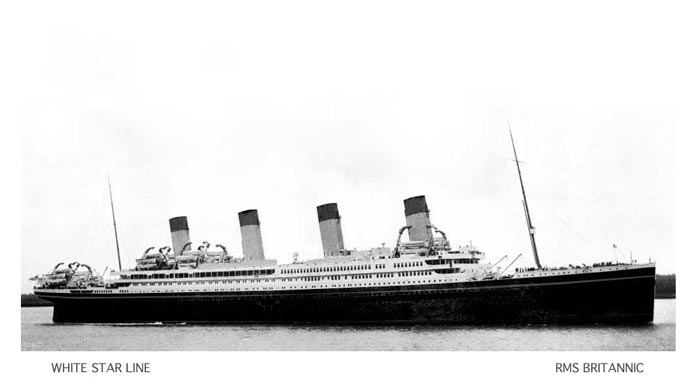Today In Pop Culture: The Britannic Takes To The Seas
Published on February 25th, 2016 in: Today In Pop Culture |Thanks to the movie magic of James Cameron and the pesky Celine Dion song, millions of people know all about the good ship RMS Titanic. How everyone on board was happy, from the rich people in first class to the immigrants in steerage. How Billy Zane went nuts and tried to shoot Leonardo DiCaprio. How the ship hit an iceberg, split in half, and sank like a stone. How even that wasn’t enough to kill Kathy Bates, because not even God can kill Kathy Bates.
The Titanic had two sister ships, the RMS Olympic and the RMS Britannic. They don’t get a whole lot of play. Nobody talks about them much. Please note, however, that today is the day the Britannic was launched.
After the Titanic sank, and the inherent design flaws were exposed, care was taken not to make the same mistakes again. Waterproof double hulls were installed on both passenger decks instead of just one. Builders installed giant grabbers that not only held six lifeboats, but could even pick up more lifeboats from the other side of the ship, if necessary. There were 48 lifeboats total, and they could hold 75 passengers each.
While the Britannic was launched on this date in 1914, it never got to sail under full glory as an international cruise ship. World War I was underway, and the military was conscripting ships like the Britannic for wartime use. The White Star Line, owners of the Britannic, pulled the ship right back in to port.
This lasted until 1915, when the British Admiralty decided to use the Britannic as a hospital ship. The ship gained a letter, becoming HMHS (His Majesty’s Hospital Ship) Britannic. The ship transported sick and wounded soldiers from the battlefront back to the United Kingdom. It did that special duty five times.
On the morning of November 21, with 1,065 people on board, there was an explosion. The force of it took out the watertight bulkhead, and water flowed into four of the airtight compartments. Sea water began to rush into the boiler room. Nurses had opened some of the portholes to get some fresh air into the lower infirmary decks. Water poured in through those, too, and it was soon obvious that the Britannic was doomed.
The crew began to panic. There was hysteria at the lifeboat stations. People tried to take the boats without permission. The captain made an attempt to steer the ship towards an island, thinking he could strand the craft on the beach.
This didn’t work.
Two of the lifeboats, filled with people, hit the water and were sucked into the propellers. The boats, and the people in them, were ripped to shreds. The captain cut the engines in time to save a third lifeboat, but it was too late for the first two.
The crew got as many people into the lifeboats as they could. When they had done all they could, the crew escaped to the engine room. But the Britannic was, in a literal sense, dead in the water. 55 minutes after the explosion, the Britannic became the largest ship sunk in World War I.
Amazingly, 1,035 people survived the incident. The ship, however, is the biggest ship currently resting on the ocean floor that is not broken in pieces. The water was only 400 feet deep. It can by explored by scuba divers, but it is registered as a British war grave.
Like its sister ship, the Titanic, the Britannic has been claimed by the very thing she was built to conquer: the sea.
Oh, and the third sister ship, the Olympic? It was a fine ship. It ruled the seas for 25 years, with only minor incidents to mar her record.
Boring.

Time limit is exhausted. Please reload the CAPTCHA.